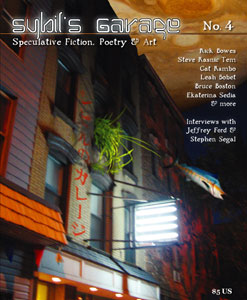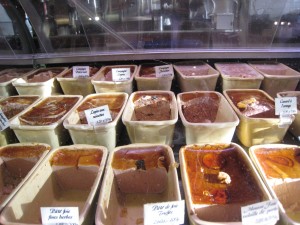If you’re in the Boston area, get yourself to Sapporo Ramen in the Porter Exchange and order a bowl of the Spicy Miso.
No wait. Don’t.
Why not? Because I’m going to build it up too much. You’ll be disappointed. And you’ll probably tell me so, and honestly, I don’t want to know. So here’s the deal: Go, and if you don’t like it or it’s not sufficiently authentic or your mom makes it better or you discover that they make their ramen broth with the flesh of roly-poly puppies, don’t tell me, okay? If we can agree on that, go with my blessing. Or not.
So what do you actually get? A large bowl filled with a milky reddish-brown broth, piled with ramen noodles, spicy ground pork, sweet corn, hard-boiled egg quarters, and a strip of nori. The broth tastes almost peanut-buttery it’s so rich. The pork is crunchy and hot and there’s not too much of it. The corn is, well, canned corn, but the nori adds the little bit of Japanese lagniappe that locates the soup’s origins better than a GPS. Sweet, salty, creamy, crunchy, with just a little bit of burn. It’s good. Really, really good. So much so that I needed to figure out how to make it here in the relative wilds of North Carolina.
Ramen is much more complicated than I ever realized and I won’t even try to claim I understand all the variants. Folks vastly more serious about the subject have catalogued at least 22 different styles, most the trademark of a particular Japanese prefecture. The soups can be soy-based, salt-based, pork-based, chicken-based; some places add seafood, some don’t. The color can be anywhere from light and clear to a cloudy white, thick with emulsified pork fat and marrow. Toppings range from the sublime to the ridiculous, too many to list.
The soup I was looking for is, unsurprisingly, based on the Sapporo style. The addition of miso to a rich fatty broth is traditional, along with that corn. The area is cold so they don’t fool around. Just to make sure there’s enough fat, an additional slab of butter is a common option as well.
It took me a while to find my way to all of this, and in the meantime I wanted ramen. So:
David Chang’s Momofuku cookbook has been getting a massive amount of buzz lately and after browsing a few pages and seeing he’s at least as in love with pork as I am, I bought a copy. It’s a charming book; Chang’s a bit of a goofball who fell into success through the back door and he comes across as cheerfully bewildered to suddenly be the food world’s darling. He also goes far out of his way to make sure his staff gets due credit for their recipes in the book which is kind of refreshing. The first few chapters describe the history of his first restaurant, a plywood-walled ramen shack in the East Village and that’s where I stole my recipe for broth.
Chang breaks ranks with tradition right away in his recipe for dashi. Dashi is the mother-liquid of Japanese cuisine, the equivalent of chicken or veal stock in European cooking. It’s usually made of a simmered strained mix of kombu seaweed and bonito flakes. Chang claims he couldn’t get good bonito flakes when he started Momofuku, so he needed an alternative, a smoky meaty flavoring agent readily available in the US. Which is kind of awesome, because that meant Chang wound up making his dashi with *bacon*.  If his references to Formula 51 and Berry Gordy’s The Last Dragon hadn’t already convinced me, that sealed it. David Chang is my brother by another mother.
Trader Joes sells Niman Ranch bacon and our local Asian grocery is fairly large, though after dark it has at most two flickering fluorescents for the entire store. It looks like a J-horror movie set but the woman who runs the store isn’t actually a yÅ«rei. She helped me locate the pile of other ingredients I needed.
I don’t have the freezer space for even more soup (I make chicken stock fairly often) so I veered from Chang’s recipe quite a bit, using up what I had kicking around. A couple of meaty pork bones, a beef knuckle, a pile of saved chicken skin, a few thighs, and a cornish game hen carcass went into the oven under high heat with some aromatics to get a good brown and build up a fond on the bottom of the pan. All of this was eventually destined for the pot with the bacon, kombu, and some dried shiitakes. First though, I needed to make taré.
Taré is one of those cooking things that’s probably so obvious to someone grounded in Japanese cuisine as to seem not worth mentioning. As a result many home attempts to duplicate Japanese dishes taste like crap. Chang describes it as Japanese barbeque sauce which doesn’t quite cover it but it would go too to describe it as Japanese demiglace. What it is is a mixture of deglazed fond, rendered fat, and bones and such, simmered in mirin, soy, and sake. It’s amazing stuff and goes a long, long way toward making ramen broth taste right. (The chicken fat sounds gross but it really is essential to the taste. In the book, Chang describes a yakitori place in Japan where the drippings from the massive daily output of grilled chicken are just channeled directly down into the taré jar to be boiled down with the mirin and sake each day. After tasting it, I can understand why.)
With the taré completed and the ramen broth simmered to a reasonable flavor level, my first attempt at putting it all together wasn’t bad. Though I intend to try at some point, even I wasn’t masochistic enough to try making alkaline noodles that evening. (I still need to get the chemicals for that in any case.) The dried noodles purchased from the Asian grocery were a reasonable compromise, boiled until barely done and washed and massaged under cold water to get out the starch and enhance the chew. The poached chicken thighs from the stockpot were glazed with taré, broiled, and served in the broth with the noodles, along with some sliced shallots, greens, and corn. It made for a passable meal.
Lunch today was the first attempt at replicating the bowl that inspired this whole mad project in the first place. Miso and sesame paste added an additional creaminess to the broth (For next time I need to remember that like adding flour, you need to make a paste of the hot broth with your grainy ingredients before adding them to the pot) and I happened to have some leftover spicy ground beef which, while not quite authentic, made a decent substitute the ground pork. For folks who keep kosher, it really doesn’t lose anything for the exchange; exclude the pork bones from the ramen broth and you’re golden. Finished off the bowl with boiling broth, warmed noodles, quartered hard boiled eggs, corn, and a good lashing of sesame-chili oil and while it wasn’t perfect, I think it was quite probably the best Sapporo-style ramen for at least a hundred miles in any direction.


